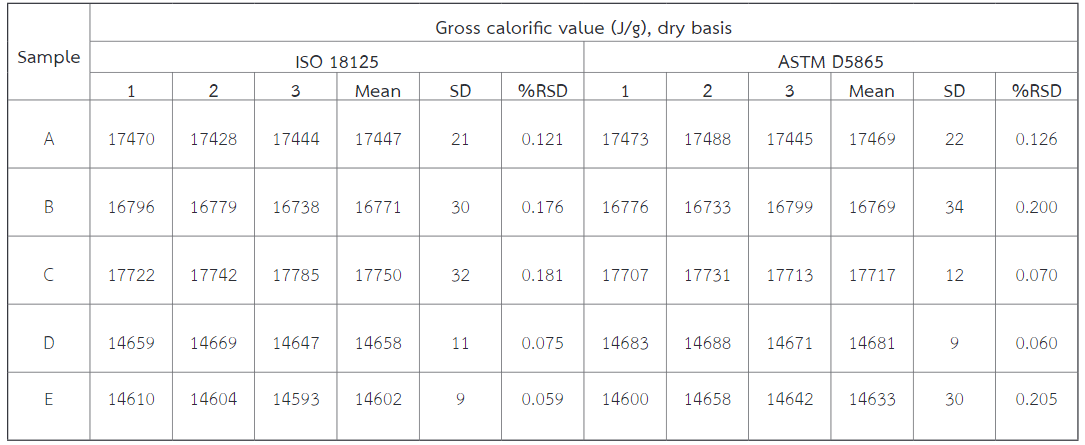Comparison of gross calorific value in biomass between standard test method ISO 18125 and ASTM D5865
DOI:
https://doi.org/10.60136/bas.v10.2021.146Keywords:
Gross calorific value, Biomass, ISO 18125, ASTM D5865Abstract
In this study, comparison of gross calorific value between ISO 18125 and ASTM D5865 in five types of biomass, including bagasse (A), sugarcane leaf (B), rubber wood (C), rice husk (D) and coconut shell (E), will be conducted. The results of gross calorific value are as follows: rubber wood > bagasse > sugarcane leaf > rice husk > coconut shell. The interval values of percentage relative standard deviation (%RSD) obtained from both methods are similar which are 0.07 -0.21% and 0.08 - 0.18% for the ASTM D5865 and ISO 18125 method, respectively. For student's t-test, it was found that tcal < tcritical. Therefore, there is no significant difference between calorific value of biomass sample from both methods at 95% confidence level. Hence, ASTM D5865 method can be applicable to determining gross calorific value in biomass samples.
References
INTERNATIONAL ORGANIZATION FOR STANDARDIZATION. ISO 18125:2017. Solid biofuels – Determination of calorific value. 2017.
INTERNATIONAL ORGANIZATION FOR STANDARD IZATION. ISO 1928:2020. Coal and coke - Determination of gross calorific value. 2020.
ASTM INTERNATIONAL. ASTM D5865-19. Standard test method for gross calorific value of coal and coke. 2019.
ASTM INTERNATIONAL. ASTM E711-87 (1996). Standard test method for gross calorific value of refuse-derived fuel by the bomb calorimeter. 1996.
STANDARDS AUSTRALIA. AS 1038.5-1998. Coal and coke - Analysis and testing gross calorific value. 1998.
GERMAN INSTITUTE FOR STANDARDIZATION. DIN 51900-2:2003-05. Determining the gross calorific value of solid and liquid fuels using the isoperibol or static jacket calorimeter and calculation of net calorific value. 2003-05.
สำนักงานมาตรฐานผลิตภัณฑ์อุตสาหกรรม. มอก. 2772-2560. เชื้อเพลิงชีวมวลแข็งอัดเม็ด. 2560.
KPALO, S.Y., M.F. ZAINUDDIN, L.A. MANAF and A.M. ROSLAN. Production and characterization of hybrid briquettes from corncobs and oil palm trunk bark under a low pressure densification technique. Sustainability. 2020, 12, 2468.
JOSE, G., G. IVAN, A. MARIA and B. JAVIER. Simulation of adiabatic gasification of corn straw using air-steam blends as an oxidizing agent. Global Journal of Engineering Sciences. 2019, 1(3).
BADAN, P., T. THEPCHATRI, E. TANAVAT, M. HARUTHAITHANASAN and K. HARUTHAITHANASAN. Fuel properties of some native tree species for biomass energy in Thailand. Thai Journal of Agricultural Science. 2020, 53(1), 53-57.
MONDRAGON-VALERO, A., B. VELAZQUEZ MARTI, D. M. SALAZAR and I. LOPEZ-CORTES. Influence of fertilization and rootstocks in the biomass energy characterization of Prunus dulcis (Miller). Energies. 2018, 11(5), 1189.

Downloads
Published
How to Cite
Issue
Section
License
Copyright (c) 2021 Bulletin of Applied Sciences

This work is licensed under a Creative Commons Attribution-NonCommercial-NoDerivatives 4.0 International License.









